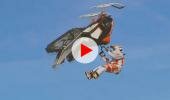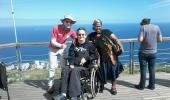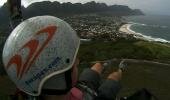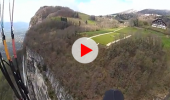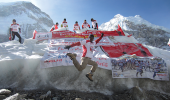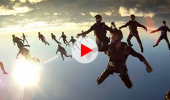Words & Photos: Kevin Lomax | Video: Courtesy of Himalaya Expeditions
If you ever arrive at a race early in the morning and bemoan the fact that you have to park miles from the starting line, then hoof it to registration and finally wait for the gun, then the Tenzing Hillary Everest Marathon is not for you.
Getting to the start of this 42.2km race involves a 66 km hike over 11 days and covers some of the most beautiful and toughest terrain on Earth. During this hike, you will ascend 2,500m from the start at Lukla to Everest Base Camp. Only then will you have the privilege of joining a small group of 200 elite athletes, weekend warriors and adventure seekers from Nepal and all corners of the globe, and running in what is arguably the world's toughest marathon.
Tenzing Hillary Everest Marathon, which starts from Everest Base Camp, has been run on 29 May since 2003, to commemorate the date that Edmond Hillary and Tenzing Norgay became the first people to summit Mt Everest in 1953. Organised by Kathmandu-based Himalaya Expeditions, the race is growing in popularity due to international runners seeking something out of the ordinary and adventurous. Running marathons really is one of the best excuses to travel and see the world, and the Tenzing Hillary Everest Marathon is a classic example of how to combine these passions.
So if this marathon is something you can see yourself doing, this is what you can look forward to.
Kathmandu
You will arrive in Kathmandu two to three days prior to departing for Lukla. This time can be spent sightseeing and being entertained in Kathmandu, an intoxicating, amazing and exhausting place. As the largest city in Nepal, its amazing cultural and artistic heritage is revealed in the hidden temples overflowing with marigolds, courtyards full of drying chillis and rice, and tiny hobbit-sized workshops that have remained largely unchanged since the Middle Ages.
Make your way to Thamel, a pre-base camp for mountaineers and centre of the tourist industry in Kathmandu, for some shopping and to stock up on any last-minute items. Thamel boasts a wide range of mountaineering gear shops that carry a range of branded products at very affordable prices, as well as some great pubs, clubs and nightlife. Expect to pay about R50 for a good curry and a few Everest Lagers.
The day before your flight to Lukla, participants are split into groups of about 30 people, according to their choice of accommodation during the hiking period; either tea houses (lodges) or camping. I highly recommend the tea house option, but for those who want to save some money and aren’t averse to the fun of camping, then you have this option. Our group consisted of people aged from 24 to 74. The 33 runners in my group had done a total of 1,048 marathons amongst them, with Maraman (David Vaughn) having done 280 marathons around the world. Several people would finish with this as their first marathon.
You are then briefed on the first part of the adventure; flight times to Lukla. As you go through departures and board the plane at Tribhuvan International Airport in Kathmandu, there's a buzz of excitement, an anticipation of what is to come. If you don’t know much about Tenzing Hillary Airport at Lukla, you've got to look it up on YouTube. Lukla is widely regarded as the most dangerous airport in the world, but don’t worry, the pilots are extremely skilled and only fly when conditions are suitable.
Lukla
Lukla is a town in the Khumbu area of the Solukhumbu District in the Sagarmatha Zone of north-eastern Nepal. Although Lukla means 'place with many goats and sheep', few are found in the area these days. Situated at 2,860 metres (9,383 ft), Lukla is the starting point of trekking routes to Everest Base Camp, Gokyo Ri, the trekking summits of Island Peak, Lobuche, Mera Peak, Kongma Ri and Kwande Ri, and the three mountain passes route: Renjo La Pass - Cho La Pass - Kongma La Pass.
When you arrive in Lukla, you'll be greeted with warm tea and lunch while you wait for your bag to arrive. Then you start hiking to Phakding (2,610m). All days of hiking are moderate and fairly easy for anyone who is prepared for a marathon. The next 10 days will have the group hiking in the shadows of the Himalayas, across trails and staying in villages such as Namche Bazar (3,440 m), Khumjung (3,760 m), Thyangboche (3,860m) - home to the world-renowned monastery, Pangboche (3,860m), Dingboche (4,285 m), Lobuche (4,910 m) and Gorakshep (5,140 m) - where you can hike to the peak of Kala Patthar (5,550 m) for panoramic views of Mt Everest, Nuptse and other peaks, until you finally arrive at Everest Base Camp (5,364 m). You get to spend two nights at Base Camp sleeping on a glacier, so expect to be cold and uncomfortable, but spell bound. The sights and sounds of the glacier, mountaineers and helicopters bringing equipment and people in is other worldly.
Race day
Finally the big day arrives. The race begins at 7 a.m. and you can expect a mad-cap start on the Khumbu Glacier, with runners jockeying for position as they clamber over rocks and skip across frozen ponds. The trick here is to pace yourself. Many a runner has gone out too hard and then had to slow down dramatically to catch their breath. The high altitude and technical nature of the trail makes it very difficult to get into your normal running tempo. Accepting this fact will make your day a lot more pleasant. Also, don’t try and keep up with the Nepali runners, as you won’t get too far.
The first 21 km of the race is the 'flatter section'. At the halfway point at Dingboche, runners have to do a 6 km loop, of which the first 3 km is uphill and then back down. Don’t let the drop in altitude fool you; the race profile includes 1,000 m of climbing. The climbs are tough, particularly the one from Pangboche to Thyanboche, the last 5 km after the descent from Thyangboche, and the climb back to the finish at Namche Bazar. Descents just don’t allow for a flying pace. They are technical and difficult, resulting in a relatively slow pace. The race finally ends at Namche Bazar to little fanfare; this is not the Two Oceans, Comrades or New York Marathon. Regardless, enjoy the experience at the finish line. Wait for your teammates to come in and swop war stories with the other runners. Due to the nature of this event, there will be an extremely diverse group of runners, with the racing snakes coming in between 3,5 and 6 hours after the start. Last year's winner, Phurba Tamang, won in 03.41:31, and the first foreigner arrived in 05.14:44.
Later that night, and if you have the energy, enjoy the night in Namche Bazaar. Go for a post-race recovery pizza or some pasta and a few hard-earned beers.
Going home
Your trip back starts the next day after lunch and is thankfully much quicker, with only a sleepover in Monjo, because most of the distance has been covered in the marathon. The following day, you will hike to Lukla and spend the night there before flying back to Kathmandu the next day. Whilst in Lukla, visit the bars, coffee shops and restaurants for a well-deserved celebration. There's even a Starbucks!
So, if you are looking for an excuse to visit the Himalayas, see iconic views and meet new and interesting people, then the Tenzing Hillary Everest Marathon should be on your bucket list.
Tips
My tips to runners considering doing the Tenzing Hillary Everest Marathon:
Tip #1: If this is something you want to do, but cannot get any of your running mates to join you, then just do it anyway. Most people are travelling alone and you will quickly make friends with other like-minded people.
Tip #2: Be open-minded. Expect to leave your comfort zone behind. This is no ordinary race, don’t expect potatoes, jelly babies and vaseline at the aid points. Consider running with a camelbak in case the aid points run out.
Tip #3: Travel insurance. Make sure you have insurance to cover any delays caused by weather and unknowns. We had to take a helicopter out of Lukla due to planes not being able to land because of fog.
Tip #4: Medication. There are doctors on the trip, but make sure you know what medication you need, including anything to help with acclimatisation if needed. Chat to your GP and visit a travel clinic for vaccinations.
Tip #5: Communicating with home. You can expect to find internet access and WiFi all the way up to Gorakshep. Having a smart phone or using their facilities means that keeping in touch with friends and family is possible, but it will hurt your pocket. WiFi is cheaper.
Tip #6: Just go and do it.
dinFO:
For more information visit www.everestmarathon.com
